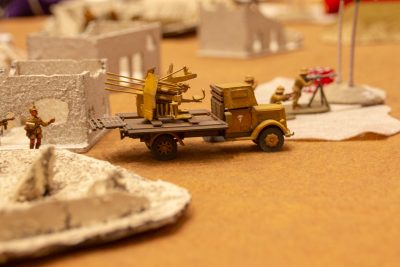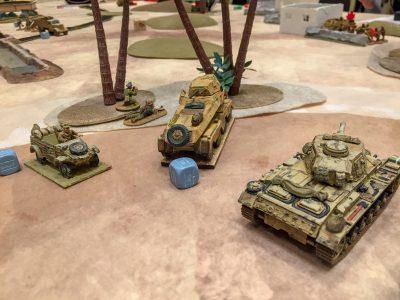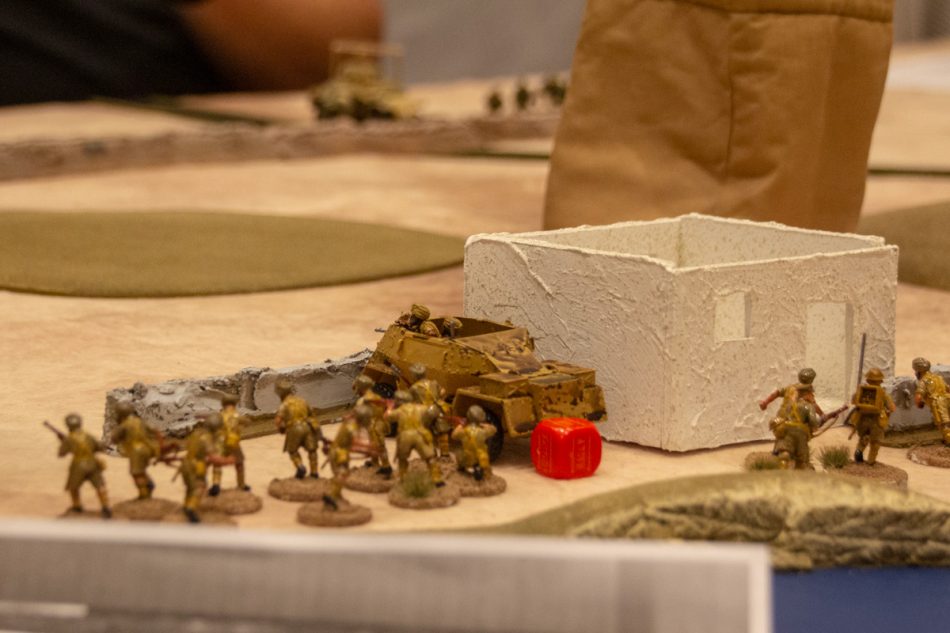Duel in the Desert: A Funzie Event Recap
, in sunny (and smoggy) Los Angeles California was recently home to a 28mm scale face-off between Rommel’s DAK and a mixed band of allies. The event was hosted by NoDiceNoGlory.com, with prize support from , and , and the chapter. This event was played with the Bolt Action rules set and featured armies primarily from the Western Desert book released last year by Warlord Games.
The event was inspired by Brad at the and based loosely on his event, Suns Out, Guns Out down in Australia, as well as inspiration from the gents at the . Even though we ran the event with tournament style, one-on-one games on 4×6-foot tables, the goal of this was for to compete for the overall victory of one’s side, and not try to dominate each game to be the top player.
Twelve players took the field of battle. Six fielded German forces. Two ran British or Commonwealth forces, with four American forces. Although I encouraged players to build lists equivalent to, or from the Western Desert (WD) force selectors, players of American forces wanted in the event. This gave me the opportunity to expand the field of potential force selector dates to Mid-1943 (ending just before the Romel’s Defeat list for the Americans.
I also asked that no vehicles with Tiger Fear be included since many of the tables had long sight lines. In addition, we ran with the Climate Effects from WD: Ice Cold in Alex, and Sand (pg 158 of WD).
Since this was the first Bolt Action “tourney style” event at the Strategicon family of game cons in several years, I was thrilled to see twelve players. Fortunately, there were a few players willing to bounce to either team as needed. We even had one returning player looking to get experience and training games with Bolt Action Second Edition, after a hiatus from First Edition.
Victory points for Win/Draw/Loss were 5/3/1. See below for how this was modified through the event.
Special Missions
Stolen from the SNAFU gents, I added one table each round that would have a special mission. Players could only compete in one special mission that day. Details of the mission were revealed right before the round began. In addition, the ability to score additional Victory Points for a personal special objective was possible in all games.
Players had a series of special objective cards, with VPs of 1 to 3 pts each. A player could select a special objective card at the beginning of the game. They would lay it face down on the table to indicate that’s what they hoped to accomplish. If they succeeded, they added that special objective’s VP to their round’s total. Some were simple, others more difficult. (and I managed to delete the Word.doc file with the cards, otherwise, I’d share it.)
Round One
 Players were faced with Scenario #9 from the main rulebook, Point Defence. Allies were automatically the defenders in this round, to illustrate the German forces seeking out enemy positions, and potential fuel and supply dumps from the enemy.
Players were faced with Scenario #9 from the main rulebook, Point Defence. Allies were automatically the defenders in this round, to illustrate the German forces seeking out enemy positions, and potential fuel and supply dumps from the enemy.
The special mission this round was Water Supply, where each force needed to capture an oasis in the center of the table. If a player controlled the water feature at the end of the game, one of their side’s forces would receive the Desert Fighter special rule for the game in Round Two. John H. (Indians) faced Rich G. (DAK). The game ended in a draw after much shooting, and both forces contesting the objective.
At the end of Round One, the Axis forces edged out the Allies, 25 pts to 22 points.
Round Two
Mission #4, Double Envelopment, was the order of the round. Because the Allies hadn’t fared so well, they selected which table to play. The Axis players then selected who to pair off against, again, with no repeating opponents.I was surprised how well this worked through the day. Players paired off with fresh opponents, on new tables. Since we weren’t running a straight tourney where wins and points determined pairings, players found their opponents and tables. We had a few repeated tables with an odd player here and there but had fresh opponents in each round.
The special mission this round was a variation of the Top Secret mission. Three objective markers were placed in buildings along the center axis of the table. Only one was the correct objective and the other two decoys. Players were to find the “briefcase” of the spy (the correct objective marker), and retreat with it off their long table edge. However, the case was booby trapped. Moving it more than 6″ in any turn risked detonating the charge. A move of 12″ in one turn was an automatic boom.
If a player succeeded in getting the objective off the table unscathed, their side would know the battle plans of their enemy for the special mission in round three. This would give them intel on which player/army was going into the special mission in round three.
Justin R. (USA) faced Jacob S. (Fallschirmjagers) on the special mission table. I watched the action once the objective was recovered. It changed hands at least four times in the game, and several rolls to see if it boomed happened as it moved over 6″ several rounds. The game ended in a draw, with no side getting it out of the center third of the table.
At the end of round two, the Axis players racked up more points and a few more wins. Total points were 62 for the Axis and 47 for the Allies.
Round Three
Mission #2, Meeting Engagement was the order for Round Three.
The special mission table was Defend the Airfield. The Axis were ahead, so they had to attack a ridgeline, and try to get two units off their opponent’s table edge. The ridge-line had two passes. Matt S. and his British put up a valiant defense, dropping his AT Gun in one pass, and his MMG in the other, with troops and carriers ready to fill any gaps. Beginning on Turn Four, Matt could roll to see if the wind was right to get a plane off. If it survived any AA fire from the opponent, it could drop an airstrike on any table.
 Unfortunately, the German side had saved the perfect force for this mission (with no foreknowledge of what the mission would be). Keith’s Light DAK Luftwaffe division, bristling with AA assets charged in and cleared both passes in turn one.
Unfortunately, the German side had saved the perfect force for this mission (with no foreknowledge of what the mission would be). Keith’s Light DAK Luftwaffe division, bristling with AA assets charged in and cleared both passes in turn one.
Matt’s British Resolve held and kept Keith from charging the airfield. But, when Matt did get a plane off the ground in turn four, there were so many AA assets on the board it didn’t stay in the air long enough to drop its payload.
In hindsight, I should have allowed the defender to have fortified positions, and make the forces close in, or eliminate the AA ability to fire on the aircraft as it took off. An unplanned airstrike on any of the tables would have helped the underdog allies greatly.
Round three finished with Keith storming the airfield (and shooting down the plane). Final scores were Axis 98, to the Allies 57.
Best General
This award was given to the player from each side who received the most votes from their opponents. Players were to rank their opponents based on which game was the most fun. Again, I used a 5/3/1 pointing system for the ranking.
John Harrel (Allied) and Felix Mundschenk (Axis) won with perfect scores of 15 each. Each received courtesy of and a starter Army box (Brit 8th Army or DAK).
Allen at GC Minis, Warlord Games, provided prizes for the other winners. They also, along with the HMGS-PSW chapter, added enough extras (wooden dice trays, blisters, and sprues) so that all players received prize support.
Best Painted
 This was selected by player votes. Again, we used a rank your three favorites, with a 5/3/1 pointing system. Brett Lynam with his Armored Cars and DAK won.
This was selected by player votes. Again, we used a rank your three favorites, with a 5/3/1 pointing system. Brett Lynam with his Armored Cars and DAK won.
Best Themed for the Desert
I asked two non-playing WWII gamers to peruse the forces and rank their top three contenders for theme (ignoring painting). Although the judges didn’t agree on the #1 choice (again a 5/3/1 system for their ranking), there was a clear winner. That winner actually finished one point behind Brett in the painting contest.
Keith Jenkins won this with his Luftwaffe 1942 Light DAK force.
The TO “Funzie” Award
This was an award for a force design that wasn’t a Kick-Butt list. Instead, I was looking for a list that was fun to play against. With the various borrowed armies in the event, I was leaning heavily toward an American list. After I heard the feedback from the two judges for best themed, I factored their historical judgment into my own decision. Peter P.’s borrowed American list was my choice, although any of the US lists could easily have taken this. Pete managed one win, against two losses through the day. The other American players were about the same with their lists.
TO Reflections
Overall, I had a fun time designing the event, as well as watching the play unfold.
 With only six players per side and four of the German players coming from the San Diego playgroup, the Axis had a strategic advantage going into the day. The allies were less organized as a team before the event but held together well on the day of. We had several players dive into the event on the allied side with borrowed American armies, as well as one player just learning the 2nd Ed rules. Had there been a better spread of players on that side, familiar with their forces, the Allies probably would have fared better.
With only six players per side and four of the German players coming from the San Diego playgroup, the Axis had a strategic advantage going into the day. The allies were less organized as a team before the event but held together well on the day of. We had several players dive into the event on the allied side with borrowed American armies, as well as one player just learning the 2nd Ed rules. Had there been a better spread of players on that side, familiar with their forces, the Allies probably would have fared better.
The Special Objective Cards gave both sides opportunities to score extra points. Again, the Axis players, who were more familiar with their lists, were able to dominate on this front as well. They had almost double the number of special objective points at the end of the event.
Playing a fun style event — where players weren’t competing for individual glory — seemed to be a fun event for the players. We had few if any rules disagreements. Players were informed early on they’d be voting for their most fun opponent, and this seemed to help everyone focus on having good and fun games.
I’m not sure when, but I’ll be running another funzie event in the near future.
Troy is a long-time wargaming grognard and retired journalist. When he’s not chasing wayward typos on No Dice No Glory, he’s usually trying to bribe his dice to roll fewer ones when they really need 4+. Needless to say, he goes through a ton of dice per year. However, Warlord’s new concentration of d10 games where rolling low is good, is finally getting him the high numbers he lacks in d6 games.

Good report and photos.
Only one thing. U did not want any German tank with tiger fear so German players could not bring Pz IV long barrel or tigers. What did the allies not be allowed to use?
Good question. If I recall, the Pz IVs with Tiger Fear weren’t available in the Western Desert Book. Since we wanted to include US forces, I had to creep the time limit forward far enough to get them regular infantry instead of Inexperienced. So they got to go as far as El Geutar. This kept them from using M10 TDs available in Rommel’s defeat.
My concern with Tiger Fear was that too many tables, set in desert terrain would be too open. Tiger Fear could easily have been a game-breaker since it’s based on line of sight. Drop a Pz IV G in the middle of your deployment zone, and anyone who can see it suffers the penalty? That effect is better balanced when the tables have more terrain.
The American lists were the only ones that went beyond 1942 of the WD book. So Tiger Fear wasn’t a factor, thanks to players keeping with the spirit of the event.